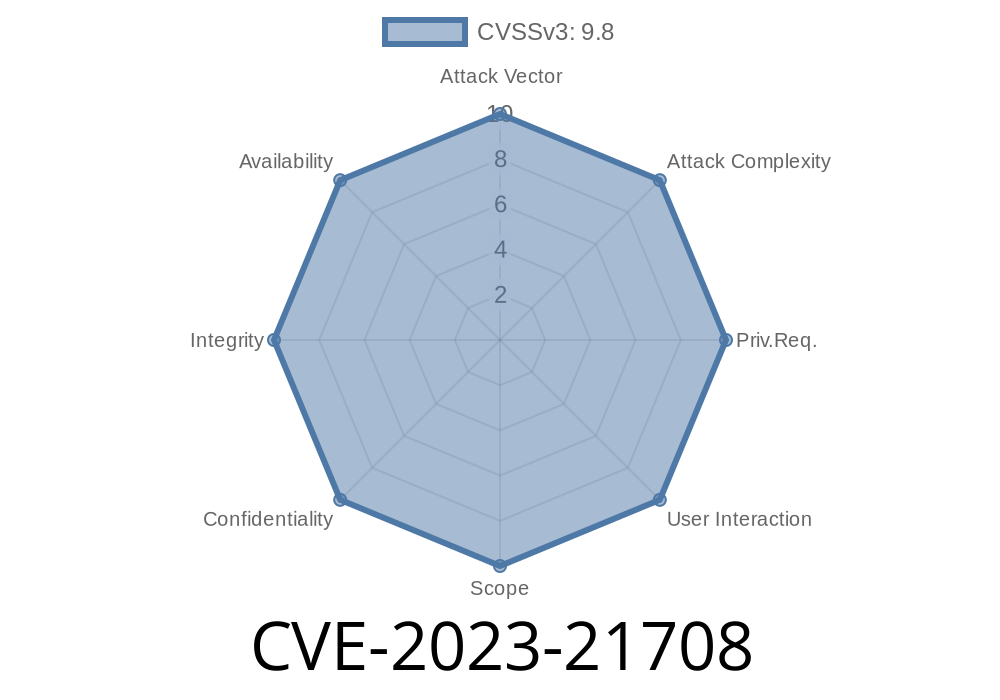In early 2023, a critical security vulnerability was published—CVE-2023-21708. Assigned a high CVSS score, this weakness impacts Microsoft's Remote Procedure Call (RPC) runtime and can allow attackers to execute code remotely on affected systems. If you're responsible for Windows infrastructure or app security, you absolutely need to understand what this means, how it works, and what you can do about it.
This article breaks down CVE-2023-21708 in plain language, walks you through how it works (with code snippets), and shares where you can read original references and vulnerable code samples.
What is CVE-2023-21708?
CVE-2023-21708 is a Remote Code Execution (RCE) vulnerability in the Windows Remote Procedure Call (RPC) runtime. RPC is a protocol that lets one program request a service from a program located on another machine in a network. The flaw lets a remote, unauthenticated attacker execute code with the same privileges as the RPC service on the targeted device.
Severity: Critical
CVSS Score: 9.8
Patched: Yes (Patch Tuesday, February 2023)
Affected Systems:
Why Is This Important?
Because RPC runs as a system service by default on Windows, exploitation could give an attacker wide-reaching access. Since it’s often exposed inside corporate networks, one infected or compromised machine can open the door for full lateral movement and domain-wide attacks.
How Does the Vulnerability Work?
The bug lies in how the Windows RPC runtime handles specially crafted RPC requests. In certain circumstances, specially created network packets can trigger a memory corruption bug, which attackers can leverage to run code of their choosing.
Key Vulnerability:
Attackers can craft and send maliciously formed RPC packets over a network to trigger a heap-based buffer overflow. This would let the attacker execute arbitrary commands with high privileges.
A malformed RPC request exploiting the buffer overflow
import socket
# This is a conceptual snippet - not directly functional for exploitation
target_ip = "192.168.1.10"
rpc_port = 135 # RPC Endpoint Mapper
# Malformed buffer (details depend on reversing the specific bug, and are not disclosed for safety)
payload = b'\x05\x00\xb\x03' + b'A' * 4096
s = socket.socket(socket.AF_INET, socket.SOCK_STREAM)
s.connect((target_ip, rpc_port))
s.send(payload)
s.close()
Note:
The real-world exploit likely requires deeper protocol abuse and memory layout knowledge. This snippet simply shows the concept: sending extra-long or malformed data to the RPC port.
The vulnerable Windows service crashes (denial of service).
- Worse, the attacker can run arbitrary code, potentially install ransomware, steal data, or move laterally on the network.
4. Real Exploit Code and PoC
Microsoft and security researchers do NOT publicly release active exploit code for this type of vulnerability before most systems are patched.
However, there is active exploit development in the wild. See this Rapid7 blog post (February 2023) and
Huntress Labs write-up for additional technical details.
Microsoft released a patch as part of the February 2023 Patch Tuesday updates.
- See Microsoft’s official advisory.
Use firewalls to restrict inbound RPC (TCP 135) access to only trusted hosts.
- Segment your networks so that sensitive servers aren’t exposed to endpoints that don’t need to reach them.
As above, check your Event Logs.
- Consider tools like Sysmon to log new processes or lateral movement on your network.
References
- CVE-2023-21708 (MITRE/NVD)
- Microsoft Security Guidance for CVE-2023-21708
- Rapid7 Blog: CVE-2023-21708 Analysis
- Huntress: What You Need to Know About CVE-2023-21708
Conclusion
CVE-2023-21708 is a critical Windows bug that can let intruders completely compromise your Windows environment through a vulnerable RPC service. The attack requires only network-level access, making unpatched systems high-priority targets for ransomware gangs and other actors.
Update now, limit network exposure, and keep an eye out for unusual RPC activity!
Timeline
Published on: 03/14/2023 17:15:00 UTC
Last modified on: 03/23/2023 16:59:00 UTC
